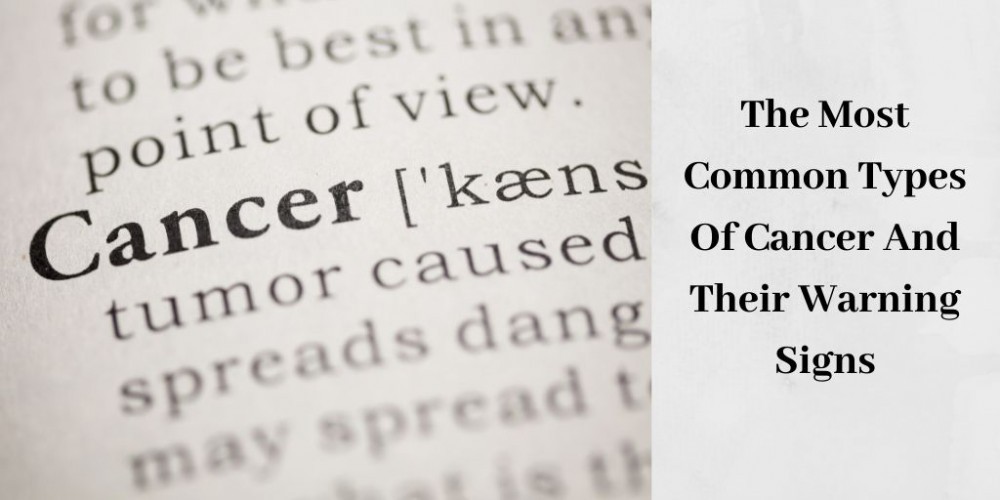Did you know there are over 100 different types of cancer, yet only a handful account for up to 75% of all diagnosed cases? Following is a list of the most common types of cancer, in no particular order, along with their early warning signs and risk factors. Protect yourself and your loved ones by being aware of the symptoms so the disease can be caught and treated in the early stages.

Affiliate links ✔️
Table of Contents
The Most Common Types Of Cancer
1. Non-Hodgkin’s Lymphoma
Non-Hodgkin’s lymphoma is not one disease, but rather a set of diseases involving the lymphocytes, or white blood cells within the lymphatic system. Lymphatic organs include the lymph nodes, bone marrow, thymus gland and spleen. Symptoms include:
- Swelling of the lymph nodes in the neck, groin, and armpits
- Fever
- Losing weight without trying
- Night sweats
- Shortness of breath
- Fatigue
- Itchy Skin
Risk factors include: gender (males are at higher risk), infections such as H. pylori and Epstein Barr, impaired immune function, and age, with certain types of the disease occurring more commonly in young adults, and other types occurring more frequently in those over 55.
[Read More: Can An H. Pylori Infection Cause Cancer?]
2. Leukemia
Leukemia is group of blood cancers that initiate in the bone marrow. There are four types of leukemia including two chronic types: chronic lymphocytic and chronic myeloid leukemia, and two acute types: acute lymphoblastic and acute myeloid leukemia. Symptoms include:
- Persistent fatigue
- Weight loss
- Swollen lymph nodes
- Easy bruising
- Bone pain
- Night sweats
- Enlarged spleen or liver
- Fever
- Increased risk of infections
- Frequent nosebleeds
Associated risk factors include: a family history of leukemia, inherited immune system conditions, exposure to chemotherapy, radiation and chemicals such as benzene, smoking and alcohol consumption, excessive sun exposure, obesity, and genetic syndromes like Down Syndrome.
 3. Pancreatic Cancer
3. Pancreatic Cancer
Pancreatic cancer, a particularly deadly type of cancer, often remains undetected until the disease is in the advanced stages.
In the beginning stages, pancreatic cancer is painless, with symptoms becoming noticeable once the cancer has become metastatic, making it difficult to treat. Symptoms include:
- A dull ache in the abdomen
- Bloating
- Pain in the back
- Nausea and vomiting
- Jaundice
Risk factors that increase the chances of developing pancreatic cancer include: age (risk goes up with age), ethnicity (African Americans and Ashkenazi Jews are at higher risk), smoking, a diet rich in fatty food, a family history of pancreatic cancer, diabetes, and gender, with more men being diagnosed with the disease than women.
4. Colorectal Cancer
Cancer of the colon, or large intestine, is one of the most common types of cancer in both men and women. It has a good prognosis if diagnosed and treated in the early stages. Early warning signs to be aware of include:
- Jaundice
- Pain in the abdomen
- Cramping and bloating
- Blood in the stool
- Rectal bleeding
- Continual fatigue
- Diarrhea and constipation
- Weight loss
Risk factors for the disease include: obesity, a family history of colorectal cancer, a sedentary lifestyle, a diet high in processed meat, regular alcohol consumption, and age, with the majority of colon cancers occurring after age 50.
Colon cancer can occur in young people, as well, including teenagers. The American Cancer Society recommends regular screenings beginning at age 45 for those at average risk for colon cancer. Screening includes stool-based tests and visual exams.

5. Lung Cancer
There are two primary categories of lung cancer, non-small cell and small-cell. Non-small cell lung cancer is the most common form, accounting for up to 85% of all cases. Sadly, over half of all cases of diagnosed lung cancer, are already in the advanced stages. Symptoms include:
- Shortness of breath
- Difficulty swallowing
- Wheezing and hoarseness
- Chronic cough
- Coughing up blood
- Pain (advanced lung cancer)
- Recurrent infections, such as pneumonia and bronchitis
Risk factors include: smoking, exposure to second-hand smoke, age (older people are at higher risk), exposure to radon gas, asbestos, radiation, and other carcinogenic compounds, a family history of lung cancer, genetics, and pollution.
6. Breast Cancer
There are two types of breast cancer, non-invasive and invasive, with the latter type potentially being life-threatening. Infiltrating ductal carcinoma and infiltrating lobular carcinoma are the two main types of invasive breast cancer.
The different receptor types determine treatment protocols. Receptor types include: estrogen receptor positive (ER+), estrogen receptor negative (ER-), progesterone receptor positive (PR+), HER2-positive (HER2+), and triple negative (ER-) (PR-) (HER2-). Signs to look for include:
- Changes in breast size or shape
- Nipple discharge or inversion
- Persistent pain in one area
- Discoloration
- Scaly patches of skin
- Redness or swelling
- Darkening of the breast
- Areas of warmth
- Skin dimpling or puckering
[Read More: 10 Facts About Breast Cancer Every Woman Needs To Know]
The chances of developing breast cancer increases with the following risk factors: obesity, a sedentary lifestyle, gender (females are at higher risk), smoking and alcohol consumption, exposure to ionizing radiation, a family history of breast cancer, never having breastfed a baby, menstruation beginning before age 12, never becoming pregnant, bearing a child at an older age, and having a care-taking personality.
7. Cervical Cancer
Most cervical cancers are caused by the HPV, or human papillomavirus. HPV is common and can be transmitted during sex.
The virus doesn’t cause any symptoms, and in the majority of cases will resolve on its own.
However, it may affect cervical changes that overtime can become cancerous. Symptoms include:
- Irregular bleeding
- Abnormal discharge
- Bleeding after intercourse
Risk factors that increase the chances of developing cervical cancer include: smoking, impaired immunity, prolonged birth control use (over five years), multiple sexual partners, and having three or more pregnancies. Regular pap smears can reduce your risk.
8. Prostate Cancer
Prostate cancer is the most common type of cancer in men, particularly those over 65. Fortunately, it’s rare in men under 40. In many cases, it is slow-growing and confined to the gland itself.
Other types can be more aggressive, spreading beyond the prostate, which can be successfully treated if detected early. The prostate sits below the bladder, which explains symptoms such as difficulty urinating. Symptoms include:
- Low back pain
- Pelvic pain or discomfort
- Difficulty passing urine
- Painful ejaculation
- Bone pain
- Erectile dysfunction
- Blood in the semen
Risk factors for prostate cancer include: age, a family history of the disease, obesity, and race, with African Americans being at greater risk of developing the aggressive form of prostate cancer.
Benign prostatic hyperplasia (BPH), bacterial prostatitis, chronic inflammation of the prostate, and acute or chronic infections also play into risk. Prostate cancer is the third leading cause of death in men in the United States, following colon and lung cancer.
9. Bladder Cancer
The most common type of bladder cancer develops in the urothelial cells that line the bladder. If diagnosed before it has spread, bladder cancer can be effectively treated. Symptoms include:
- Blood in the urine
- Urinary urgency and frequency
- An inability to urinate
- Painful urination
- Pain in the pelvic region
- Urinary tract infections
- Fatigue
- Weight loss
The risk of developing bladder cancer can be up to seven times higher if a person smokes cigarettes, pipes, or cigars. Exposure to carcinogenic chemicals (arsenic) also increases risk, as do chronic bladder problems, such as infections and stones, and age, with up to 70% of those with bladder cancer being over 65.
Caucasians are twice as likely to be diagnosed with this type of cancer, as are African Americans, yet the latter group are two times as likely to die of the disease. Squamous cell bladder cancer is associated with the parasitic infection, schistosomiasis.

 10. Esophageal Cancer
10. Esophageal Cancer
Esophageal cancer develops in the inner layer of the esophagus, the tube which connects the throat to the stomach. Adenocarcinoma and squamous cell carcinoma are the two main types of esophageal cancer. In the initial stages of the disease, there may be an absence of symptoms. Symptoms arise as the cancer progresses including:
- Coughing and hoarseness
- Heartburn
- Indigestion
- Pain behind the breastbone
- Difficulty swallowing
- Unexplained weight loss
Risk factors include: tobacco and alcohol use, smoking, GERD, and Barrett’s esophagus, a complication of gastroesophageal reflux disease (GERD), which increases the chances of developing esophageal adenocarcinoma. Early detection of Barrett’s esophagus is crucial to reduce cancer risk.
11. Liver Cancer
Hepatocellular carcinoma (HCC), or liver cancer, is the most common cancer worldwide, with the primary risk factor being chronic hepatitis, a viral infection of the liver. Both hepatitis and cirrhosis, or scarring of the liver, increase the odds of developing liver cancer. This risk significantly increases with heavy alcohol use.
Symptoms include:
-
- Fatigue
- Swelling of the abdomen
- Appetite suppression
- Unexplained weight loss
- Weakness
- Vomiting and nausea
- Jaundice
- White stools
Risk factors for liver cancer include: nonalcoholic fatty liver disease (NAFLD), excessive alcohol use, diabetes, aflatoxin exposure, and chronic infections, such as hepatitis B (HBV) and hepatitis C (HCV), which lead to liver cirrhosis.
Liver cancer is more common in men than woman, but may be due to behaviors that increase risk. A sub type of liver cancer, fibrolamellar, is more common in women. Asian Americans and Pacific Islanders are at the highest risk in the United States. Age increases risk, with those over 50 being the most likely to develop the disease.
[Read More: Can Nonalcoholic Fatty Liver Disease Be Reversed?]
12. Stomach Cancer
Stomach cancer commonly starts in the mucus-producing cells that line the stomach. Signs that signal the presence of cancer may not be apparent in the initial stages, with symptoms being mistaken for the flu. Because of this the cancer may not be detected until it’s advanced and aggressive. Symptoms include:
- Pain in the stomach
- Severe heartburn
- Indigestion
- Bloating
- Nausea and vomiting
- A feeling of fullness after eating
- Weight loss
Gastric adenocarcinoma accounts for up to 95% of all cases of stomach cancer. There are two types: intestinal type, which is found in the lower areas of the stomach, and diffuse type, an aggressive form of stomach cancer.
Risk factors for stomach cancer include: obesity, smoking, gender (male), chemical exposure, A blood type, having had stomach surgery, an active H. Pylori infection, and poor dietary habits, such as eating smoked and preserved foods. Gastric polyps, pernicious anemia, and atrophic gastritis also increase risk.
Key Points
Knowing the signs and symptoms of the most common types of cancer is important for reducing your risk. Treatment success is much brighter when the disease is diagnosed in the early stages, while the prognosis is still favorable. If you experience any new symptoms, get them checked out as soon as possible.
Did you know these types of cancer were the most common? Let me know in the comments:)
References:
(1) Mayo Clinic: Lymphoma
(2) Cancer Treatment Centers of America: Leukemia
(3) American Cancer Society: Risk Factors for Childhood Leukemia
(4) WebMD: Pancreatic Cancer Symptoms
(5) Cancer.net: Pancreatic Cancer: Risk Factors
(6) Breastcancer.org: Hormone Receptor Status
(7) CDC: What Are the Risk Factors for Cervical Cancer?
(8) U.S. National Library of Medicine: Prostate Cancer
(9) Mayo Clinic: Prostate Cancer
(10) WebMD: What Are the Symptoms of Bladder Cancer?
(11) Cancer.Net: Bladder Cancer: Risk Factors
(12) Medtronic: Barrett’s Esophagus
(13) Cancer Quest: Liver Cancer
(14) Cancer treatment Centers of America: Stomach Cancer
(15) City of Hope: Stomach (Gastric) Cancer
(16) MedicineNet: Prostate Cancer
(17) American Cancer Society: American Cancer Society Guideline for Colorectal Cancer Screening
Disclaimer: This article is strictly for informational purposes only and is not intended to be medical advice.



This is a very informative article and I do appreciate you going into detail about the warning signs of the most common types of cancer. I didn’t know that easy bruising might actually be a sign of cancer, I know someone that bruises very easily but had no idea that could be a sign of something drastic. I will ask her to see a doctor about it because I don’t believe she ever has.
Hi Sonia,
Thank you. I thought it was a timely post since many people don’t associate specific symptoms with cancer. It’s important to be aware of the early warning signs for the best outcome. Please do alert your friend about her bruising. It may be nothing, but if it is, she’ll be glad she took the initiative.
Thank you for your very well presented informative website! Everyone should read this to familiarize themselves with the complexities and symptoms of these diseases. I for one, have had to deal with a daughter who had cancer, and would have LOVED to be able to research our situation more! Hers was a Ewing Sarcoma which is apparently common to young athletic teens.
Again, thank you for the opportunity to read more about this plague with which our nation is plagued. I am unsure as to this, but I did wonder if under “lung cancer” the phrase “colon cancer” may have been misplaced?
Hi Amy,
Thanks for alerting me to my mistake. It seems that no matter how many times I proofread an article, invariably there is something I miss. I appreciate you reading my post and I’m so sorry to hear about your daughter. I’m so hope she’s doing well now. That must have been terrifying for her at such a young age. And for you and the rest of the family.
This is great information! I lost a sister-in-law to leukemia many years ago. That was my first introduction to the disease. My nephew was only 18 months when she passed away, but years later he would start crying in the middle of the night, missing his mother.
As a caregiver, I have had a few patients who were suffering from some form of cancer. It is hard to see the trauma it causes to the patients, their families, and friends.
Information such as this needs to be circulated in every form of media frequently to heighten awareness. I will play my part by posting this article on my social media platforms.
Thank you so much for sharing.
Veron
Hi Veron,
I’m very sorry to hear about your sister-in-law. That breaks my heart for your nephew. Cancer obliterates so many lives. It’s just devastating. I agree with you that it’s absolutely vital that information be circulated to heighten awareness. It’s this awareness that will save lives. Thanks for reading and taking the time to leave a comment:)
Great valuable information here and although I don’t have any symptoms that would indicate I might have any of these issues, I/we have all known someone, whether an acquaintance, close family member or a friend, who has had, does have or has died from one kind of cancer or another. Many of us for sure.
I had such an experience with a brother in church who, in the beginning complained of a sore throat. He went to the doctor many times about it. They did tests, many tests, and by the time they figured out what was going on, it was too late and he died of throat and tongue cancer. It took almost a year to figure this out.
It was sad to see such a vibrant father of two young boys have to go through that at such a young age. I don’t think he was even 30 when he passed.
As good as early diagnosis is (and I believe in it 100%), sometimes it’s not enough.
It probably wasn’t one of the common cancers but I’m sure that there were some similar symptoms. Others I’ve known have had one or the other of these, and because of early diagnosis have come through the other side in good health and most are still cancer-free today.
Cancer is nothing to fool around with. If we are experiencing two, three or four of these symptoms we should see a doctor right away and get regular checkups from our family physician. I think being proactive is going to be 90% of the cure.
Wayne
Hi Wayne,
I agree with everything you’ve said. I had an uncle who died of pancreatic cancer when I was a teenager and it was devastating. He was only in his forties and left six kids. I’m sorry to hear about your friend from church. I feel so sorry for his little boys and his wife, and of course for him having his life cut short. And what a travesty that he wasn’t diagnosed sooner than he was. It likely would have saved his life or at least prolonged it. Sadly, this is not a rare occurrence.
Cancer doesn’t have to be a death sentence. Awareness and early detection is key for a favorable outcome. However, prevention will always be the best course of action. Life is busy and it’s easy to brush aside symptoms. But if people would realize that it could potentially cost them their life, they may take the early warning signs more seriously. It’s nothing to mess around with. Thank you so much for reading and for your comment:)